大学英语词汇教学策略探究.doc
- 格式:doc
- 大小:68.50 KB
- 文档页数:5
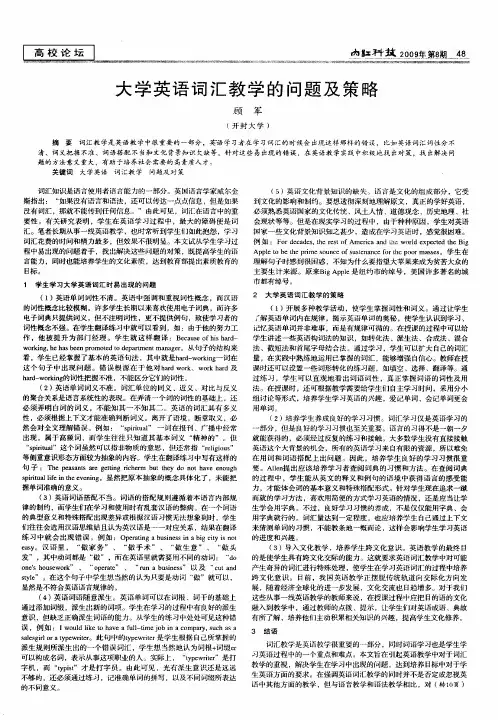
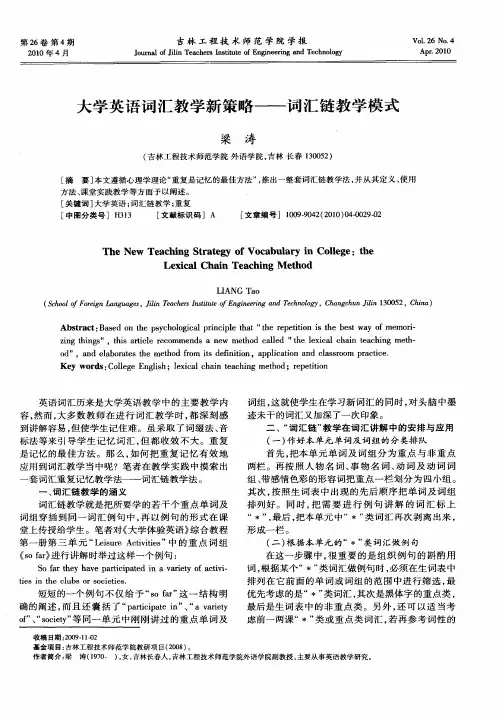
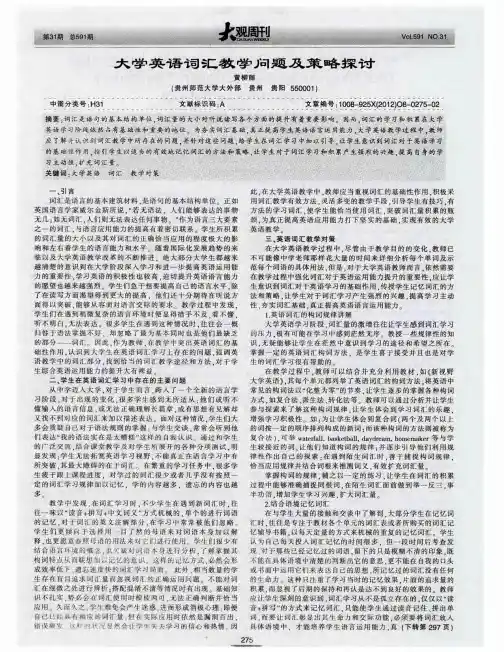
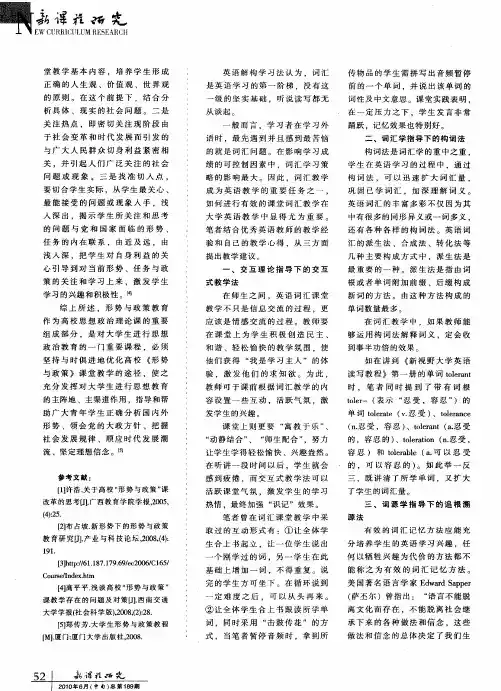
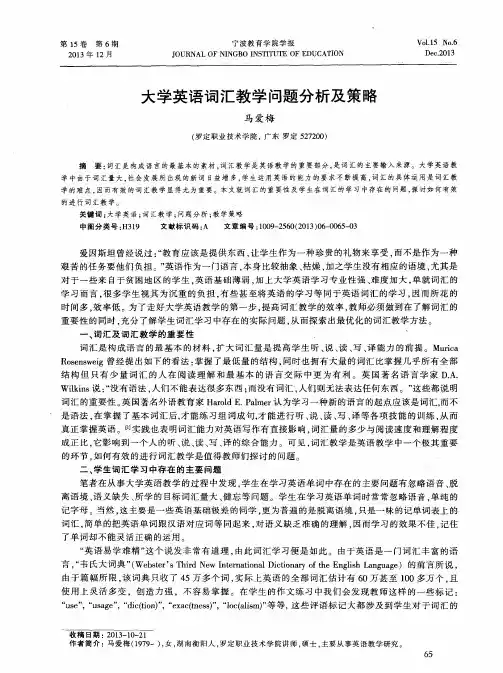
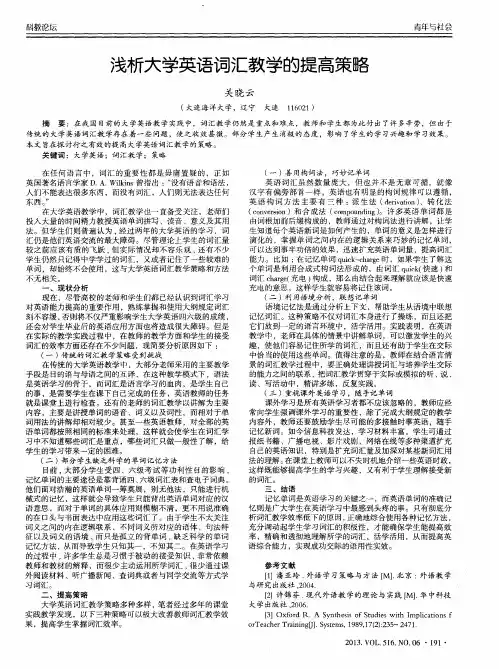
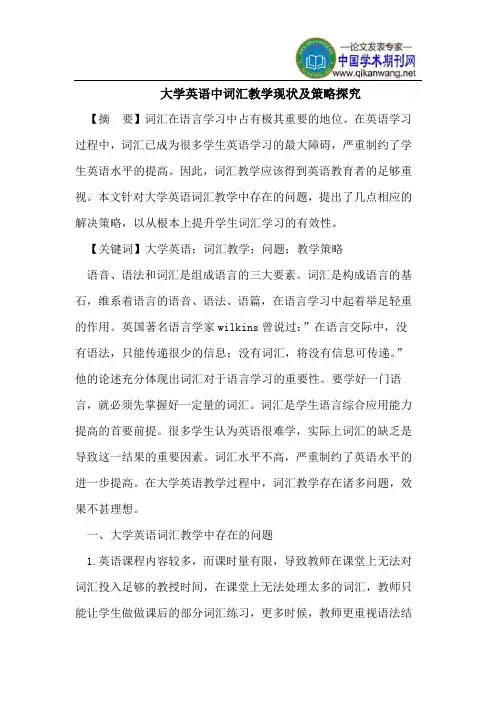
大学英语中词汇教学现状及策略探究【摘要】词汇在语言学习中占有极其重要的地位。
在英语学习过程中,词汇已成为很多学生英语学习的最大障碍,严重制约了学生英语水平的提高。
因此,词汇教学应该得到英语教育者的足够重视。
本文针对大学英语词汇教学中存在的问题,提出了几点相应的解决策略,以从根本上提升学生词汇学习的有效性。
【关键词】大学英语;词汇教学;问题;教学策略语音、语法和词汇是组成语言的三大要素。
词汇是构成语言的基石,维系着语言的语音、语法、语篇,在语言学习中起着举足轻重的作用。
英国著名语言学家wilkins曾说过:”在语言交际中,没有语法,只能传递很少的信息;没有词汇,将没有信息可传递。
”他的论述充分体现出词汇对于语言学习的重要性。
要学好一门语言,就必须先掌握好一定量的词汇。
词汇是学生语言综合应用能力提高的首要前提。
很多学生认为英语很难学,实际上词汇的缺乏是导致这一结果的重要因素。
词汇水平不高,严重制约了英语水平的进一步提高。
在大学英语教学过程中,词汇教学存在诸多问题,效果不甚理想。
一、大学英语词汇教学中存在的问题1.英语课程内容较多,而课时量有限,导致教师在课堂上无法对词汇投入足够的教授时间,在课堂上无法处理太多的词汇,教师只能让学生做做课后的部分词汇练习,更多时候,教师更重视语法结构的讲授而忽略了词汇教学,甚至把词汇学习看作语法结构的陪衬。
2.有些教师在讲解新单词时,仅仅着眼于单词的字面意思,没有把单词放在一定的语言场景中进行学习,因此,学生即便掌握了一些单词,增加了词汇量,但是这种量的提高并不能解决英语词汇学习的根本问题。
在学生对所学单词无法灵活应用的情况下,大量的词汇记忆毫无意义,极大地影响了学生英语学习的积极性。
3.缺乏有效的词汇学习策略的指导。
很多学生不懂得使用策略来进行词汇学习,只是通过死记硬背来学习单词,投入大量的时间和精力来不停地重复读写来记忆单词。
这种方法单调、乏味,学生容易产生厌倦心理,收效甚微。
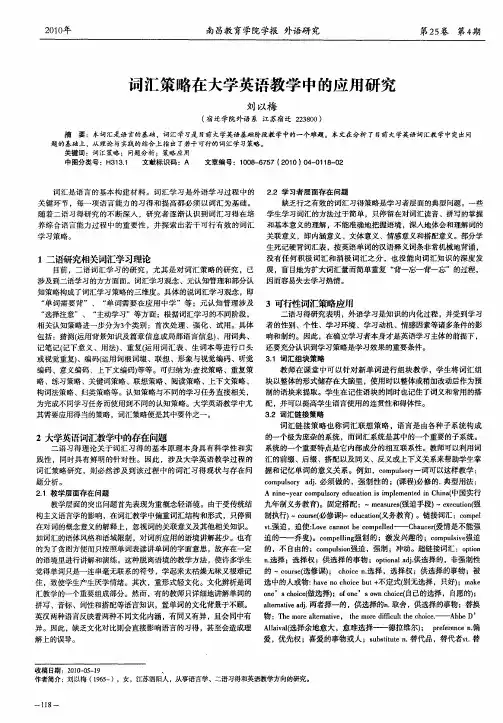
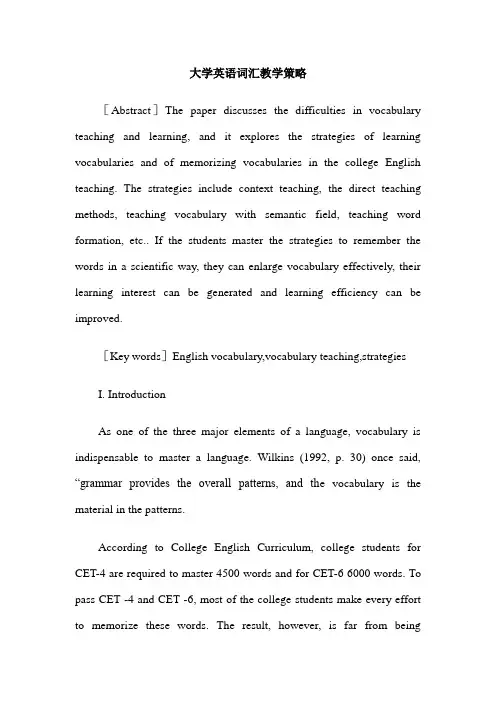
大学英语词汇教学策略[Abstract]The paper discusses the difficulties in vocabulary teaching and learning, and it explores the strategies of learning vocabularies and of memorizing vocabularies in the college English teaching. The strategies include context teaching, the direct teaching methods, teaching vocabulary with semantic field, teaching word formation, etc.. If the students master the strategies to remember the words in a scientific way, they can enlarge vocabulary effectively, their learning interest can be generated and learning efficiency can be improved.[Key words]English vocabulary,vocabulary teaching,strategiesI. IntroductionAs one of the three major elements of a language, vocabulary is indispensable to master a language. Wilkins (1992, p. 30) once said, “grammar provides the overall patterns, and th e vocabulary is the material in the patterns.According to College English Curriculum, college students for CET-4 are required to master 4500 words and for CET-6 6000 words. To pass CET -4 and CET -6, most of the college students make every effort to memorize these words. The result, however, is far from beingsatisfactory. Thus, how to improve English vocabulary teaching so as to achieve the vocabulary teaching task has become an urgent problem.Traditionally, there are three kinds of common practice in vocabulary teaching. Perhaps the most common way to teach vocabulary is by presenting the unfamiliar list of individual word items before the learners encounter the texts. Secondly, some teachers only ask their learners to memorize the word lists at the back of their course books without paying any attention to how they are used in real language contexts. What’s worse is that they cannot equip their learners with the ability to use the words correctly in their language production work. In order to solve these problems, this paper is drafted. This paper will illustrate some different strategies to help students master vocabulary, if students can use them in an effective and scientific way, they will remember vocabulary easily.Ⅱ. Previous Studies on English V ocabularyTeaching at HomeIt was not until 1980 that we Chinese began to research into language learning strategies. Wen Qiufang (1996, p. 66), in his book On English Learning Strategies, expands learning strategy system, the innate factors of the system as well as how to coordinate and control otherfactors affecting strategies selection.However, most of the current researches emphasize on theory analysis and only some of them deal with empirical research. Besides, some principles are unpractical in real teaching. Therefore, we need to gather experience in daily teaching class in order to improve the methods of teaching vocabulary.Ⅲ. The Problems of V ocabulary Learning andTeaching in College3.1 Low efficiency in mastering vocabularyEnglish learning and teaching are considered as “consuming more time but achieving less efficiency”. Allen (2000, p. 44) claims that teachers give little attention to methods to help students learn vocabulary. They spend plenty of time on remembering words, but they find it hard to remember vocabulary and easy to forget. Gradually, these students lose their interest in English because they find it hard to learn the words by heart.3.2 Putting more emphasis on grammarIn English class, teachers pay much attention to grammar. When analyzing a sentence, the teachers often concentrate on sentence ratherthan vocabulary. Teachers read the new words and point out its meaning in some text. Furthermore, the national college entrance examination tests basic knowledge, including grammar, tense, and count and so on. As a result, teachers spend more time teaching grammar than vocabulary in class.Ⅳ. The Strategies of College English V ocabulary Teaching4.1 Context teachingContext means the words that come just before and after a word, phrase or statement and help you to understand its meaning. Thus words should not be taught out of context. Moreover, context teaching caters to students for an effective reading and communication by making use of the words they have learnt. More importantly, context teaching helps cultivate students’good habits of reading between the lines. For example, in Unit1 of College English, Book 2, there is a sentence containing a new phrase: “That magazine story, and the person who wrote it, I have never been able to track down.” In light of the context, we can guess the meaning of “track down”, which means “find” or “discover.” Then let’s add one more example: “It was almost two weeks before the police tracked down the facts they needed.”4.2 The direct teaching methodThe Direct teaching method means teachers give a class directly, often by a kind of auxiliary teaching equipment, such as pictures, material object, PPT and gestures, expressions and so on.Harmer (2000, p. 55) said, “The teacher can also ensure that the students understand the meaning of a word by showing pictures (photographs, cards. etc).”For instance, when a teacher teaches a book, he can take an actual book, points out the book and says “book.” Then she takes another book and says “book” Students will understand “a book” is a book after teachers repeat “a book.” With the development of science and technology, the computer is a common teaching tool, so teachers can use PPT to show pictures to teach what a tree, bank, plane is.4.3 Teaching vocabulary with semantic fieldThe basic assumption underlying the theory of semantic field is that words do not exist in isolation: rather, they form different semantic fields, such as a vegetable field which contains all kinds of words that denote vegetables: spinach, cauliflower, cabbage, pepper, eggplant, onion, tomato, cucumber. Words that belong to the same semantic class are in the same semantic field. According to the theory of semantic field, the meaning of a word is decided by its relationships with other words in the same semantic field. There are various kinds of such sense relationships, for example, hyponymy, part/whole relationships, synonymy andantonymy. By association of words in the same semantic field, we can train our students to constantly deepen their recollection of words learnt and reinforce learning and retention of newly learnt words.4.4 Teaching word formationWord formation is an effective way to help students see words in the network of association. As McCarthy (2001, p. 87) puts it: to know the meaning of a word becomes the task of knowing its associations with other words. Therefore, to teach lexical items effectively, teachers must familiarize students with these common roots, prefixes, suffixes. For example, in teaching the word “transplant” students are told that the prefix transmits across; beyond; into another place or state. When they are aware of the meaning of organ (liver, kidney, heart) transplant, they are asked to tell the meanings of the following words with a given context: transport, transform, translate, transact, transfer, transit, transatlantic, transparent, translucent. While learning the word scribble, the root -scribe is taught first. It means to write.The most productive are affixation, compounding and conversion. According to Hogben and Lawson, (1993, pp. 145-147) words produced through affixation constitute 30﹪to 40﹪of the total number of new words; compounding yields 28% to 30% of all the new words; conversion brings 26﹪of the new vocabulary into modern English.4.5 Teaching usage of wordsLinguist Brown (2001, p. 34) points out: the word is only really acquired if the learner can use it actively and correctly, or has efficient recall of it in a variety of contexts. So our efforts to acquire a large vocabulary should never culminate in better comprehension. As we all know, the ultimate purpose of vocabulary development is to help learners to communicate effectively with these words learnt. Thus it is necessary for teachers to teach usage of words that is, to explain the collocations, to learn idioms, related proverbs and to distinguish synonyms.1. CollocationCollocation is a difficult but important part of vocabulary acquisition. Merely knowing the Chinese meaning of a word does not guarantee correct use of the word. Take a look at the following example. It is right to say “open the door”, “open fire”, but “open TV”, “open the light” or “open an operation” do not make much sense to a westerner. Instead, “turn on the TV”, “turn on the light”, “perform an operation” should be used.In teaching “ restrain”, if students are given the nouns and prepositions that go with it, they can have phrases like restrain one’stemper/anger/laughter, restrain sb from doing sth. In addition, they canhave the collocations of its noun form restraint: submit to restraint, break loose from all restraints, without restraints.2. IdiomsIdioms learning arouses students interest in learning new words, hence enhances their memory of these words. Take the idiom “let the cat out of the bag” as an example, students understand every word, but they have no idea about the meaning of the idiom. After given a context, they are able to know its meaning to tell a secret by a mistake. Thus students are taught not to be easily contented with merely knowing the individual word; they should learn idioms for better understanding.3. ProverbsProverbs in every culture are considered crystal of human wisdom. Making use of related proverbs in vocabulary teaching stimulates students’interest. Take the following proverbs as examples:A hedge between keeps friendship green. (similar proverb: good fences make good neighbor.)To err is human, to forgive is divine.Many kiss the baby for the nurse’s sake.A horse stumbles with four legs. (The italicized words are newwords to be learned.)Ⅴ. ConclusionThis thesis mainly discusses the strategies of vocabulary teaching, and of course, everyone realizes the importance of the vocabulary. Just as Wilkins once said, “without grammar, only a little information could be covered, without vocabulary, no information could be covered.” So, vocabulary is the key to language learning. However, learning vocabulary is not easy thing. In this thesis, it illustrates some problems which lie in vocabulary teaching and learning. In order to tackle these problems, the thesis puts forward some strategies, including context method, direct teaching method, semantic method, word formation method, and teaching usage of words.If students master these strategies, they will find it less difficult to master vocabulary than before. So, teachers should teach students how to learn instead of what to learn.【References 】[1]Brown, HD. 2001. Teaching by principle: An Interactive Approach to Language Pedagog[M].Foreign Language Teaching and Research Press.\[2\] Hamre, J. 2000. How to teach English[M].Foreign Language Teaching and Research Press.\[3\] Hogben, D, Lawson, M. J. 1993. Strategies for foreign language vocabulary acquisition[M].Western Australia: The Annual Conference of the Australia Association for Research in Education.\[4\] McCarthy, M. 2001. V ocabulary[M].Oxford: Oxford University Press.\[5\] Wen, Qiufang. 1996. On English learning strategies [M].Foreign Language Teaching Press.\[6\] Wilkins, D. A. 1997. V ocabulary linguistic in language teaching [M].London: Eduard Arnold Ltd..\[7\] Wilkins, D.A. 1997. National syllabuses[M].Oxford: Oxford University Press.[摘要]本文对大学英语词汇教法进行了探究,如:情景法、直观教学法、语义场法、构词法等策略。
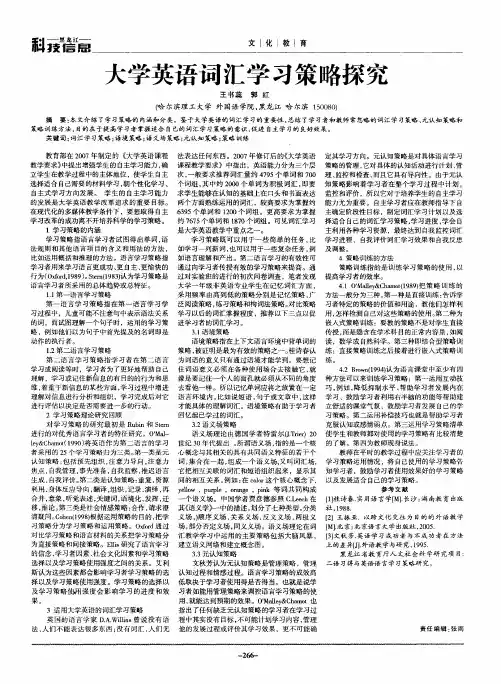
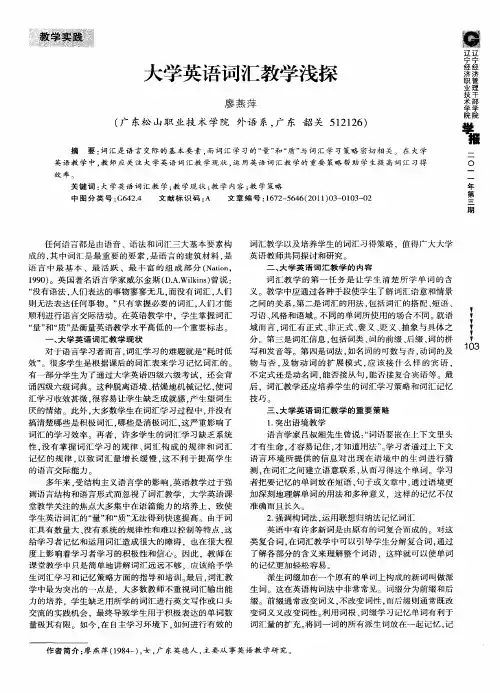
大学英语词汇教学策略探究
关键词:词汇教学策略输入内化输出
摘要:本文作者根据认知心理学的相关理论探讨了如何在潜移默化中帮助学生更快、更好、更全面的掌握词汇。
从词汇的输入、内化、输出三个环节入手制定出一套切实可行的词汇教学方案。
任何一种语言的学习都离不开字、词汇的学习与掌握,英语的学习亦是如此。
英语词汇教学是英语教学的重要组成部分,词汇掌握得多少,直接影响学生外语能力的发展和运用。
所以利用认知心理学的相关理论,科学地进行词汇教学,提高学生的单词记忆能力,防止遗忘,是英语教学中一项十分重要的任务。
根据认知心理学信息加工理论,词汇的学习可以分为输入,内化和输出三个环节。
(一)词汇输入
词汇的输入包括音、形、两方面。
读音方面:教师应提供大量听音、模仿和实践的机会,帮助学生读准音。
可使用以下方法:1、听录音跟读;2、老师示范领读;3、听课文注意语音语调。
拼写方面:通过掌握单词的拼读规则和发音规则,增强学生对单词的记忆能力。
在此环节,注重字母、字母组合在单词中的发音,并注重发音规律的渗透。
有意识地培养学生见词就能拼读,听音就能拼写的能力。
使学生们逐渐具有语言感知的能力。
(二)词汇内化
在英语词汇教学方面,众多专家一致认为词不离组,组不离句,句不离段。
这充分体现了语境在记忆单词方面的作用。
否则,记忆只能是浅层记忆不够深入。
没有语境即使记忆了很多单词也不能够学以致用。
因此,应该从以下两方面入手对所学词汇进行内化。
(1)在语境中记忆单词。
词汇学习不是孤立的,从读音、拼写记忆词汇只能使学生通过读音记住、拼出单词,但单词的实际意义还得放入情境交流中,才能显示出生命力和交际功能。
才能培养学生实际语言运用能力。
许多语言学家的研究表明:第一语言学习者的词汇知识多数来自大量的阅读,可见,在语境中学
习词汇是词汇自然习得的主要途径。
所以,教师应重视培养学生在语境中推断词义的能力,这就要求教师选择适合语境教授词汇的材料,并尽可能在语境中呈现词汇,
传统的机械重复记忆脱离语境。
在学习英语的过程中,只注重了学习当时的记忆效果,孰不知,要想做好学习的记忆工作,单纯的注重当时的记忆效果,而忽视了后期的保持和再认是达不到良好的效果的。
只有在语境当中才能真正的全面地掌握其用法。
在这一环节中,除了课文创设的语境之外,还要向学生提供更多的语境材料。
把抽象概念的词放在短语、句子或课文中教,使学生对词的理解具体化。
采用归纳比较的方法,以新带旧、以旧学新,新旧知识联系以加深理解和记忆。
在课文的呈现中注意培养学生对语言文本中生词的猜测能力。
遇见生词要学生反复听、反复读,看邻近的上下文,分析其在句中的关系。
让学生去思考,通过以前所学的知识去推知遇到的新词义,以激发学生的求知欲。
(2)在单句语境中操练词汇。
在单句语境中,让学生根据具体语境再认再现所学的单词拼写及用法,为减轻难度特给首写字母或汉语意思。
这种操练的主要目的是让学生体会单词、词组在不同语境中的用法,以便更深层次理解掌握单词。
(三)词汇输出
教师的任务不只停留在向学生不断输入新词汇和巩固已有词汇上,教师还要为学习者创造机会应用记忆库里的词汇,也就是让学生有语言输出的机会,即写和说,语言输出是词汇学习的重要步骤,如果不能正确使用认识的词汇,那么,这些词汇只能是你的接收词汇,而不是输出词汇,也就不能说完全掌握了这些词汇。
对于学生输出的语言材料,教师可以用恰当的方式为学生纠错,以加深理解,巩固记忆,使学生真正掌握所学词汇,达到扩大词汇量的目的。
翻译句子、编写对话、命题作文等练习都可以帮助学生对所学词汇进行输出练习。
总之,词汇在一个人的语言能力发展中起着至关重要的作用,词汇量的大小直接影响听说读写译各项能力的发展,学生的词汇量越大,对语言输入内容的理解能力就越强,输出语言材料时质量就越高。
针对学生词汇学习中的种种困惑和误区,我们在日常的教学工作中应以学生的学习兴趣、生活经验和认知水平为出发点,注意词汇教学的连贯性和层次性,通过体验、实践、参与、合作与交流的学习方式和任务型的教学途径,培养学生实际运用词汇能力,发展学生的综合语言运用能力。
[1]崔义平.英语词汇学习三维途径理念下的词汇教学原则[J].外语与外语教学,2005,(4):28-31.
[2]韦汇余.构筑英语词汇教学的立体空间[J].连云港教育学院学报,2000,(2):45-49
[3]梁晓波.认知语言学对英语词汇教学的启示[J]外语与外语教学,2002,(2):35-39.
[4]赵艳芳.认知语言学概论[M].上海:上海外语教育出版社,2001.
相关查阅:毕业范文、计算机毕业。